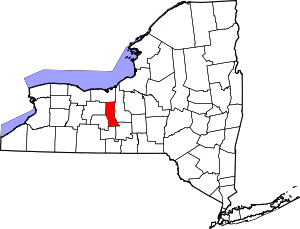Interlaken, New York
| Interlaken, New York | |
|---|---|
| Village | |
 Interlaken, New York Location within the state of New York | |
| Coordinates: 42°37′5″N 76°43′27″W / 42.61806°N 76.72417°WCoordinates: 42°37′5″N 76°43′27″W / 42.61806°N 76.72417°W | |
| Country | United States |
| State | New York |
| County | Seneca |
| Area | |
| • Total | 0.3 sq mi (0.7 km2) |
| • Land | 0.3 sq mi (0.7 km2) |
| • Water | 0.0 sq mi (0.0 km2) |
| Elevation | 906 ft (276 m) |
| Population (2000) | |
| • Total | 674 |
| • Density | 2,632.7/sq mi (1,016.5/km2) |
| Time zone | Eastern (EST) (UTC-5) |
| • Summer (DST) | EDT (UTC-4) |
| ZIP code | 14847 |
| Area code(s) | 607 |
| FIPS code | 36-37528 |
| GNIS feature ID | 0974030 |
Interlaken is a village in Seneca County, New York, United States. The population was 674 at the 2000 census. The name is related to the village's position between two lakes.
The Village of Interlaken is in the northern part of the Town of Covert and is northwest of Ithaca, New York.
History
The village was previously known as "Farmer Village" and "Farmer." Interlaken was incorporated as a village in 1904 and given its current name. The name was changed in a deal with the Lehigh Valley Railroad which agreed to make the town a stop on its line which ran between the lakes if the name were changed to one more marketable for tourism. The First Baptist Church of Interlaken was listed on the National Register of Historic Places in 2002.[1]
Geography
Interlaken is located at 42°37′05″N 76°43′27″W / 42.618012°N 76.724229°W.[2]
According to the United States Census Bureau, the village has a total area of 0.3 square miles (0.78 km2), all of it land.
Interlaken is at the junction of New York State Route 96, New York State Route 96A, and County Road 141.
Interlaken is in the Finger Lakes District and is between, but not adjacent to, Seneca Lake and Cayuga Lake.
Demographics
As of the census[3] of 2000, there were 674 people, 256 households, and 175 families residing in the village. The population density was 2,632.7 people per square mile (1,000.9/km2). There were 280 housing units at an average density of 1,093.7 per square mile (415.8/km2). The racial makeup of the village was 97.77% White, 0.89% African American, 0.30% Native American, 0.59% from other races, and 0.45% from two or more races. Hispanic or Latino of any race were 1.48% of the population.
There were 256 households out of which 37.9% had children under the age of 18 living with them, 51.6% were married couples living together, 13.7% had a female householder with no husband present, and 31.6% were non-families. 28.1% of all households were made up of individuals and 13.3% had someone living alone who was 65 years of age or older. The average household size was 2.51 and the average family size was 3.05.
In the village the population was spread out with 28.6% under the age of 18, 6.2% from 18 to 24, 25.2% from 25 to 44, 20.8% from 45 to 64, and 19.1% who were 65 years of age or older. The median age was 39 years. For every 100 females there were 81.7 males. For every 100 females age 18 and over, there were 77.5 males.
The median income for a household in the village was $31,518, and the median income for a family was $40,625. Males had a median income of $32,308 versus $21,058 for females. The per capita income for the village was $14,782. About 9.5% of families and 11.5% of the population were below the poverty line, including 13.1% of those under age 18 and 6.8% of those age 65 or over.
Notable people
- Rod Serling - screenwriter, producer and narrator
References
- ↑ "National Register Information System". National Register of Historic Places. National Park Service. 2009-03-13.
- ↑ "US Gazetteer files: 2010, 2000, and 1990". United States Census Bureau. 2011-02-12. Retrieved 2011-04-23.
- ↑ "American FactFinder". United States Census Bureau. Retrieved 2008-01-31.
| |||||||||||||||||||||||||||||||||
